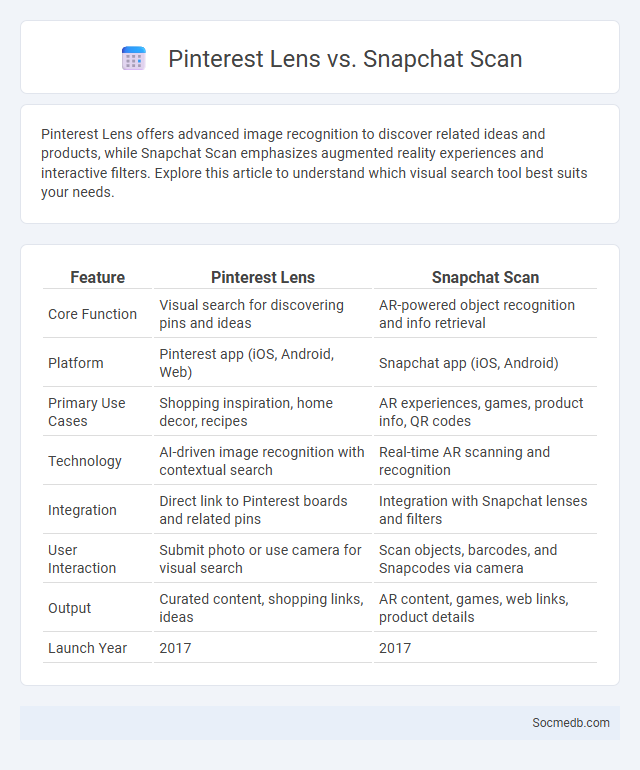
Photo illustration: Pinterest Lens vs Snapchat Scan
Pinterest Lens offers advanced image recognition to discover related ideas and products, while Snapchat Scan emphasizes augmented reality experiences and interactive filters. Explore this article to understand which visual search tool best suits your needs.
Table of Comparison
| Feature | Pinterest Lens | Snapchat Scan |
|---|---|---|
| Core Function | Visual search for discovering pins and ideas | AR-powered object recognition and info retrieval |
| Platform | Pinterest app (iOS, Android, Web) | Snapchat app (iOS, Android) |
| Primary Use Cases | Shopping inspiration, home decor, recipes | AR experiences, games, product info, QR codes |
| Technology | AI-driven image recognition with contextual search | Real-time AR scanning and recognition |
| Integration | Direct link to Pinterest boards and related pins | Integration with Snapchat lenses and filters |
| User Interaction | Submit photo or use camera for visual search | Scan objects, barcodes, and Snapcodes via camera |
| Output | Curated content, shopping links, ideas | AR content, games, web links, product details |
| Launch Year | 2017 | 2017 |
Overview: Pinterest Lens, Snapchat Scan, and Lens
Pinterest Lens uses advanced image recognition to help you discover related ideas and products by simply snapping a photo. Snapchat Scan integrates augmented reality and AI to identify objects, barcodes, and even solve math problems, enhancing interactive social media experiences. These innovative visual search tools transform how users engage with content, making your social media interactions more intuitive and personalized.
Key Features Comparison
Social media platforms offer varied key features such as real-time messaging, multimedia sharing, and algorithm-driven content feeds, which enhance user engagement and personalization. Instagram excels in visual content with Stories and Reels, while Twitter prioritizes concise updates and trending hashtags for real-time conversations. Facebook integrates comprehensive tools including Groups, Marketplace, and Events, facilitating community interaction and e-commerce within a single ecosystem.
Technology Behind Each Visual Search Tool
Visual search tools leverage advanced technologies such as artificial intelligence, machine learning, and computer vision to analyze and interpret images on social media platforms. These technologies enable your device to recognize objects, faces, and scenes, enhancing the accuracy and speed of search results. By integrating neural networks and deep learning algorithms, social media apps optimize user engagement through personalized and contextually relevant visual content discovery.
User Interface and Experience
A well-designed social media platform prioritizes an intuitive user interface (UI) that enhances navigation through clear icons, consistent layouts, and responsive design elements. User experience (UX) improvements, such as personalized content feeds, fast loading times, and seamless interaction features like real-time notifications and easy multimedia sharing, significantly increase user engagement and retention. Optimizing accessibility and minimizing cognitive load through simple, user-friendly interfaces further contributes to a positive, inclusive social media experience.
Accuracy and Speed of Visual Recognition
Advancements in artificial intelligence have significantly enhanced the accuracy and speed of visual recognition on social media platforms, enabling real-time content filtering and user engagement analysis. Leveraging deep learning algorithms and convolutional neural networks, platforms can instantly identify objects, faces, and contextual elements within images and videos, reducing the spread of misinformation and inappropriate content. This technology supports personalized user experiences by quickly analyzing visual data to recommend relevant content and advertisements with high precision.
Integration with Other Platforms
Social media seamlessly integrates with various platforms such as e-commerce sites, email marketing tools, and customer relationship management (CRM) systems to enhance user engagement and data-driven insights. APIs and cross-posting features allow your content to reach wider audiences while maintaining consistent branding across channels. Leveraging these integrations boosts marketing efficiency and drives measurable results for your digital strategy.
E-commerce and Shopping Capabilities
Social media platforms have transformed e-commerce by integrating seamless shopping capabilities such as shoppable posts, in-app checkout, and personalized product recommendations driven by AI algorithms. Features like Instagram Shops and Facebook Marketplace allow businesses to directly engage with users, enabling instant purchases without leaving the app. Enhanced analytics tools on these platforms help brands optimize advertising strategies and improve customer targeting to boost conversion rates.
Privacy and Data Security Concerns
Social media platforms collect vast amounts of personal data, increasing risks of privacy breaches and unauthorized access. Users often lack control over their information, leading to potential misuse by third parties and targeted advertising. Enhancing data encryption and transparent privacy policies is crucial to safeguard user information and build trust.
Platform-Specific Use Cases
Social media platforms cater to distinct user needs, with Instagram excelling in visual storytelling through photos and short videos, ideal for brands focusing on aesthetics and lifestyle marketing. LinkedIn serves professionals seeking networking, job opportunities, and industry insights, making it essential for B2B marketing and career development. Twitter specializes in real-time updates and news sharing, effective for public relations, customer engagement, and trending topic discussions.
Future Trends in Visual Search Technology
Visual search technology in social media is advancing rapidly with the integration of AI-powered image recognition and augmented reality, enhancing user experience by allowing seamless product discovery and interaction. Future trends include more precise object detection, contextual understanding, and real-time visual queries that will enable brands to deliver personalized content and advertisements directly within image feeds. This evolution is set to transform e-commerce on social platforms by simplifying the path from visual inspiration to purchase.
 socmedb.com
socmedb.com